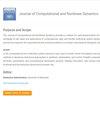机器人假肢和外骨骼的节能致动器设计原则:系列弹性和反驾驶性综述
IF 1.9
4区 工程技术
Q3 ENGINEERING, MECHANICAL
引用次数: 2
摘要
传统上,机器人假肢和外骨骼是使用高齿轮传动系统设计的,这种系统最大限度地利用了人类运动的被动动力学,导致执行器效率低下,需要大量的能量消耗,从而提供有限的电池供电操作或需要大型板载电池。在这里,我们回顾了两种领先的节能致动器设计原则,用于腿式和可穿戴机器人系统:串联弹性和反向驱动性。正如行走的逆动力学模拟所示,有一段时间的负关节功可以通过使用串联弹性执行器和/或具有能量再生的反驱动执行器来回收一些否则耗散的能量来提高效率。串联弹性作动器可以提高地面冲击时的抗冲击能力,通过机械能的储存和返回,降低电机的峰值功率和能耗。然而,具有串联弹性的执行器往往具有较低的输出扭矩,由于增加了物理弹簧而增加了质量和结构复杂性,并且力和扭矩控制带宽有限。具有低传动比传动的高扭矩密度电机,也被称为准直接驱动,同样可以实现低输出阻抗和高反向驱动性,除了能量再生之外,还可以实现安全、合规的人机物理交互。然而,转矩密集的电机往往具有更高的焦耳热损耗,更大的电机质量和惯性,并且需要专门的电机驱动器进行实时控制。虽然每种驱动器设计都有其优点和缺点,但在日常生活的各种运动活动中,设计者应该考虑机器人假肢和外骨骼的能源效率。本文章由计算机程序翻译,如有差异,请以英文原文为准。
Energy-Efficient Actuator Design Principles For Robotic Leg Prostheses And Exoskeletons: A Review Of Series Elasticity And Backdrivability
Robotic leg prostheses and exoskeletons have traditionally been designed using highly-geared motor-transmission systems that minimally exploit the passive dynamics of human locomotion, resulting in inefficient actuators that require significant energy consumption and thus provide limited battery-powered operation or require large onboard batteries. Here we review two of the leading energy-efficient actuator design principles for legged and wearable robotic systems: series elasticity and backdrivability. As shown by inverse dynamic simulations of walking, there are periods of negative joint work that can increase efficiency by recycling some of the otherwise dissipated energy using series elastic actuators and/or backdriveable actuators with energy regeneration. Series elastic actuators can improve shock tolerance during foot-ground impacts and reduce the peak power and energy consumption of the motor via mechanical energy storage and return. However, actuators with series elasticity tend to have lower output torque, increased mass and architecture complexity due to the added physical spring, and limited force and torque control bandwidth. High torque density motors with low-ratio transmissions, known as quasi-direct drives, can likewise achieve low output impedance and high backdrivability, allowing for safe and compliant human-robot physical interactions, in addition to energy regeneration. However, torque-dense motors tend to have higher Joule heating losses, greater motor mass and inertia, and require specialized motor drivers for real-time control. While each actuator design has advantages and drawbacks, designers should consider the energy-efficiency of robotic leg prostheses and exoskeletons during various locomotor activities of daily living.
求助全文
通过发布文献求助,成功后即可免费获取论文全文。
去求助
来源期刊
CiteScore
4.00
自引率
10.00%
发文量
72
审稿时长
6-12 weeks
期刊介绍:
The purpose of the Journal of Computational and Nonlinear Dynamics is to provide a medium for rapid dissemination of original research results in theoretical as well as applied computational and nonlinear dynamics. The journal serves as a forum for the exchange of new ideas and applications in computational, rigid and flexible multi-body system dynamics and all aspects (analytical, numerical, and experimental) of dynamics associated with nonlinear systems. The broad scope of the journal encompasses all computational and nonlinear problems occurring in aeronautical, biological, electrical, mechanical, physical, and structural systems.

 求助内容:
求助内容: 应助结果提醒方式:
应助结果提醒方式:


